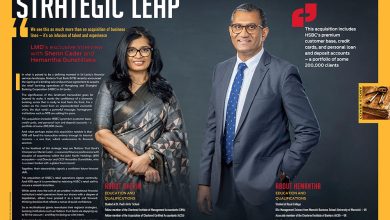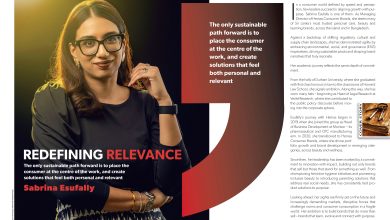
EXCLUSIVE
BANKING ON INTEGRITY
Aruni Goonetilleke evaluates developments taking place in the banking sector given the ongoing and imminent digital and macroeconomic changes at the national and regional levels

Positioned among the highest echelons of the banking sphere, Aruni Goonetilleke is the Chairperson of Hatton National Bank (HNB). Serving on the boards of several listed and private sector companies as a Non-Executive Director, she possesses decades of corporate experience and knowledge of financial markets.
 Goonetilleke was previously the Head of Corporate Banking of People’s Bank and Chief Risk Officer of Standard Chartered Bank in Sri Lanka.
Goonetilleke was previously the Head of Corporate Banking of People’s Bank and Chief Risk Officer of Standard Chartered Bank in Sri Lanka.
In addition, she counts extensive international banking exposure, having occupied senior positions at Standard Chartered Bank in Singapore – she was its Head of Credit in Commercial Banking and Head of Credit in SME, as well as Senior Audit Manager.
Goonetilleke counts specialist experience in several areas including enterprise risk management, credit, audit and business development.
A reputed figure in women empowerment initiatives, Goonetilleke has also worked tirelessly to drive inclusion and diversity in the workplace. Her actions stem from a firm belief that gender equality is a catalyst to fortify communities and in turn, will accelerate economic development.
In this exclusive interview with LMD, Goonetilleke examines the state of the banking sector in Sri Lanka and shares her take on its future, and outlines the need for proactive steps to strengthen the financial services industry.
– LMD

Q: How do you view the Sri Lankan financial market’s performance given the impact of the pandemic and ensuing economic uncertainty?
 A: COVID-19 has affected global financial markets in unexpected ways, threatening the very existence of businesses and people.
A: COVID-19 has affected global financial markets in unexpected ways, threatening the very existence of businesses and people.
The pandemic was not envisaged nor planned – this perfect black swan event pulled the plug on financial markets. It sent them into a tailspin with governments struggling to cope with the twin issues of people’s health and safety, while protecting their incomes and livelihoods.
COVID-19 had a significant impact on frontier markets such as Sri Lanka. Periodic travel restrictions imposed to curtail the spread of the virus also disrupted business and impeded economic growth.
The external sector has been challenged with the widened trade deficit, capital market outflows and impact on tourism while the sovereign downgrade by credit rating agencies has exerted further pressure on the already weak external position.
The banking sector – which is the lifeline of the economy – has continued to demonstrate resilience and stability despite multiple challenges Additional capital and liquidity buffers built over time have enabled banks to sustain themselves in difficult times.
Meanwhile, the non-banking financial institution (NBFI) sector has faced more challenges as the effects of moratoriums on smaller balance sheets are compounded.
The equity market performed particularly well last year as the All Share Price Index (ASPI) surpassed 12,000 points, which was a record performance. This was largely driven by local investors while foreign institutions were substantial net sellers. Therefore, proactive and immediate steps to attract foreign investors back to the equity and bond markets are a strategic imperative.
Q: What is your assessment of Sri Lanka’s monetary policy during the pandemic and the likelihood of it normalising in the foreseeable future?
A: The country’s monetary policy during the period mirrored strategies adopted across developed and emerging economies. With the shock delivered by COVID-19 globally, central banks were compelled to effect monetary easing and stimulus measures.
As for emerging economies, the impact on countries such as Sri Lanka was exacerbated. Consequently, the lowering of policy rates and statutory reserve ratios, as well as other easing measures, were timely. This resulted in private credit growing 13.8 percent year on year up to September.
However, this inevitably led to pressure on the currency and upward pressure on prices as we have already witnessed. The Central Bank of Sri Lanka (CBSL) is cognisant of this and stepped in to break the loosening cycle through policy rates, beginning the normalisation process.
The average weighted prime lending rate (AWPLR) has increased by more than 200 base points (bps) since the policy rate hike. Meanwhile, the one year Treasury bills rate increased by nearly 300 bps by the end of 2021 and bonds maturing in May 2025 were traded at rates exceeding 11 percent, indicating rising interest rates.
Q: According to the World Bank, the South Asian region’s economic growth is expected to be 7.1 percent in 2022. However, recovery has been uneven across economies and sectors. Against this backdrop, what is your outlook for the regional financial markets in the long term and how is this likely to affect Sri Lanka?
 A: The pandemic saw the South Asian region contract by 5.4 percent in 2020 compared to the 3.5 percent global contraction.
A: The pandemic saw the South Asian region contract by 5.4 percent in 2020 compared to the 3.5 percent global contraction.
Many countries experienced lower investment flows and supply chain disruptions, setbacks to human capital accumulation and increased debt. The pandemic is estimated to have caused 48-59 million people to become or remain poor in South Asia.
Economic growth in the region will partly depend on developed nations’ recovery, and the policy measures adopted by the US Federal Reserve and European Central Bank. The outlook remains positive as most developed economies have recovered well on the back of substantial post-COVID monetary stimulus packages.
With the emergence of new digital technologies, South Asia has an opportunity to shift gears from a traditional manufacturing led growth model and capitalise on its service sector’s potential.
However, there is a possibility of further external shocks. As the pandemic continues to evolve with new COVID-19 variants and China’s Evergrande group declared to be in default by S&P Global, there may be disruptive impacts on regional and global growth.
Meanwhile, Sri Lanka’s economy was projected to grow by 3.3 percent last year from a contraction of 3.6 percent in 2020. The country is at a crucial juncture, which requires immediate and sustainable solutions.
However, with the aggressive vaccination programme being rolled out across the island, and given the potential for growth in sectors such as tourism, exports, ICT, knowledge process outsourcing (KPO), business process outsourcing (BPO), agriculture, healthcare and education, as well as Colombo International Financial City (CIFC a.k.a. Port City), we see potential for growth and recovery.
Q: Taking the importance of SMEs into consideration, what opportunities and barriers do they face in the prevailing business environment? And how are banks addressing these factors?
A: There are gaps in understanding and addressing the pain points in the SME segment. These are the most affected clients as they lack the financial strength and capacity to endure prolonged lockdowns and business disruption.
Business continuity planning, recovery strategies, risks, controls, financial management and the use of technology are a few of the areas that need to be improved. This calls for initiatives aimed at uplifting the segment.
The SME sector is the engine of economic growth and we see immense potential for it as the country recovers. However, more needs to be done at the national level in terms of policies and sustainable solutions to address funding structures, and capacity and capability gaps.
Q: What is the risk appetite of Sri Lanka’s banking sector in the prevailing environment?
A: Both large and small businesses have experienced existential threats, and the banking sector was called on to extend debt moratoriums.
In most cases, companies were not able to pay their interest obligations, resulting in banks carrying non-earning assets and impairments being substantially higher due to stressed assets.
Individuals were laid off or salaries have been slashed, resulting in their inability to pay loans or credit cards. With distressed asset sales, the value of collateral has also declined. All these factors coupled with uncertainty led to banks having a reduced risk appetite in 2020.
Last year however, the sector observed an improvement in clients’ performance. For example, the assets under moratoriums at Hatton National Bank (HNB) fell below 10 percent towards the end of 2021 from 40 percent in the previous year. Lending has also increased across all sectors including micro, small and medium enterprises (MSMEs), large corporates and individuals.
Digitalisation was a positive development in the pandemic, enabling us to get money digitally to a broader segment of society.
Our ability to provide US Dollar liquidity remains challenging due to the reduced dollar inflows. Despite the mandated conversions, the inflow isn’t sufficient to meet the import bill. This is a challenging situation for our clients and we are attempting to accommodate as many of them as possible.
The first quarter of this year is crucial in terms of how we manage this crisis and the extent to which the Central Bank’s six month plan produces results.
The sovereign downgrade also meant that local banks found it more difficult to raise medium to long-term funds due to international lenders’ reduced risk appetites. However, Sri Lankan banks continue to maintain their credibility in global markets due to the prudent management of dollar exposure and timely repayment of obligations.

Q: What are the core components of organisational risk governance and culture? And which areas should the banking sector improve on in terms of these aspects?
A: Most banks would have a defined risk appetite approved by their boards, which plays a central role in the development of strategic plans and policies.
Below this, banks have risk tolerance limits, portfolio caps and standards, to ensure that exposure to high-risk trading activity is prudent and liquidity management is sound.
Banks also conduct stress tests to ensure that they operate within their expressed risk appetite across geographies, customer segments and products.
But these are useless without a strong risk culture Ð the tone and behaviour have to come from the top. Embedding a healthy risk culture involves an enterprise level ability to identify and assess, openly discuss and take prompt action to address existing and emerging risks. Banks’ ERM should set out guiding principles for their people, enabling them to have integrated and holistic risk conversations across the three lines of defence.
In my view, Sri Lankan banks need to improve this to establish a more robust rewards scheme for risk-based returns and by rewarding such thinking (including remuneration decisions), challenging the status quo, and creating a transparent and safe environment for employees to communicate risk concerns.
There is also increasing focus on issues relating to ESG (environmental, social and governance) risks from regulators and investors. This could lead to significant reputational risks, and banks need to find tools to assess if a client relationship can leave it open to ESG risks and their potential severity.
Sri Lankan banks have come a long way but due to the growing cybercrime and financial crime risks, they need to stay on top of their game to identify and mitigate potential risks. To this end, they need to continuously invest in technology and be innovative.
There is also a need to embed climate risk management into mainstream risk management. Measuring climate risks remains an industry wide challenge even for international banks, and they need to invest in internal capabilities and external partnerships.
We can certainly benefit from global best practices. However, clients also need to evolve in this regard and local banks should adopt a model that is appropriate for Sri Lanka.

Q: As we witness the emergence of decentralised banking in some parts of the world, what are your views on the increasing use of cryptocurrencies?
A: While the original concept for crypto was conceived in the 1980s, it was only in 2009 that the first decentralised cryptocurrency was established. Since then, the field has grown exponentially with an explosion of different cryptocurrencies being traded. Especially in the recent past, we have seen more interesting innovations particularly in decentralised finance (DeFi).
Presently, cryptocurrency’s popularity exceeds the understanding of how it works, and there are still massive gaps in regulation and oversight. Some states including China have outlawed their use while others are debating solutions including central banks potentially issuing ‘alt currencies.’
It seems clear that blockchain and crypto are here to stay. As uses evolve, cryptocurrencies will undoubtedly change the financial ecosystem. The impact this will have on the global economy needs to be assessed and a balance struck, whereby there is some regulation and extensive education to protect the public interest.
 Q: In your view, will decentralised banking become a part of Sri Lanka’s financial services system in the near future?
Q: In your view, will decentralised banking become a part of Sri Lanka’s financial services system in the near future?
A: I believe decentralised banking will take some time to come to Sri Lanka officially. While there are Sri Lankans already investing in cryptocurrencies, they do so at their own risk since it is not regulated and the legal framework is far from clear.
DeFi proponents would say that it offers several advantages including the reduced cost and speed of transactions. Intermediaries such as banks are eliminated and therefore, the hope is that transaction costs reduce and finance will reach a broader segment of people more quickly.
They also say that due to the underlying technology and embedded risk management controls, it is safer to conduct financing in this manner. Opponents note that the checks and balances provided by banks and other financial intermediaries are essential to protect customers.
Blockchain for trade transactions and payments will come sooner, since this is supported by underlying assets and would be done with banks collaborating with each other.
While there have been high profile expressions of interest in the space, CBSL has not yet approved cryptocurrencies for transactions. It has also outlined the risks to the public, highlighting that people using them should bear the risks.
More recently, Sri Lanka’s cabinet of ministers appointed a committee to study the potential opportunities and threats that could emerge from the use of blockchain and cryptocurrency. If they see sustainable value for the nation, a suitable framework may be proposed. Therefore, the industry will need to be ready for disruption.
Q: With the rise in digital transactions, what measures are in place to prevent identity theft and online fraud? And are they sufficient, in your view?
A: Cybersecurity is a constantly evolving field, and with the precipitation of digital and contactless transactions in the wake of COVID-19, there are more opportunities for identity and online fraud.
As security protocols increase in sophistication, we will continue to see cybercriminals attempting to use more complex methods.
Fortunately, the regulator has been proactive on this front and so too the banks, which have invested substantially in IT security encompassing areas such as two factor authentication, biometrics and other advanced technologies.
However, we need to look at continuously raising the bar in information security standards and this requires continuous investment. There is also more work to be done in educating customers about the types of fraud that can be committed and best practices they need to adopt to keep themselves safe from such attacks.
 Q: CBSL rolled out the LANKAQR initiative to create space for convenient and affordable digital transactions between customers and merchants. Do you believe this is the right step towards inclusive banking – and what more needs to be done?
Q: CBSL rolled out the LANKAQR initiative to create space for convenient and affordable digital transactions between customers and merchants. Do you believe this is the right step towards inclusive banking – and what more needs to be done?
A: The national quick response for local currency payments (LANKAQR) is indeed a step in the right direction. With mobile penetration being high in Sri Lanka, mobile devices are regarded as the way forward for enhancing financial inclusion.
As customers can now make payments to any merchant accepting LANKAQR, it increases flexibility for users, unlocks tremendous potential for merchants Ð particularly smaller merchants struggling to bear the costs associated with setting up conventional POS solutions Ð and promotes a cashless payment system.
Continuous investments in upgrades to enable customer requirements, effective communication and marketing at the national level, stakeholder engagement and commitment along with good ecosystem management are integral elements that need to be undertaken or continued.
Q: Are there lessons for Sri Lankan corporates to learn in the context of coming out of the multiple crises brought on by the pandemic – including cash flow and HR management?
A: While many global companies offered flexible working arrangements prior to the onset of COVID-19, others were compelled to shift due to the pandemic. Such arrangements promote employees’ work-life balance as well as productivity while improving engagement with a focus on their mental health. This is of paramount importance.
However, there is certainly a need for employees to return to work in many cases where face-to-face interaction is required.
Remote working arrangements brought about their own risks, which had to be managed. Simultaneously, training and upskilling teams to meet the disruption by offering them adaptability and technological skills are vital.
On the other hand, effective cash flow management (collections and less stock holding) reduces the dependence on debt and leads to more sustainable funding structures.
Meanwhile, focussing on digitalisation, innovation, improving internal controls, and ensuring transparent and continuous stakeholder engagement are essential lessons.
Organisations are also compelled to be mindful of changing customer needs and tastes, and acknowledge the need to adapt and innovate.
At the same time, they must focus on social needs, incorporating inequality concerns, and undertaking sustainable and value adding business. This comes at a time when value chains have been disrupted, which need to be secured by supporting the entire chain.

Q: What is your vision for Sri Lanka’s corporate leadership? And how must the status quo be disrupted to empower more leaders from within the ranks of potential female CEOs as well as the next generation?
A: Businesses must prioritise driving ESG in a manner that ensures the next decade of corporates will be more ethical and sustainable than before. One’s integrity and honesty are becoming more important than how they were perceived in the past.
Strong oversight from board audit committees is becoming increasingly important, and ‘short-termism’ and ‘making a quick buck’ are no longer fashionable.
Business must be conducted with purpose and value addition to the entire ecosystem. This begins with having a purpose in what you do; it should not be a mere job but a passion.
Furthermore, the fact that diversity brings business results is now firmly established. Diversity of thought is critical, and most consumers and buying decision makers happen to be women. Globally and unlike in any other era previously, there is a powerful movement towards gender equality, human rights and diversity.
And importantly, a business is not sustainable unless its leaders operate with a moral-cum-ethical compass.
All these factors will help change the corporate leadership profile in Sri Lanka, creating more female leaders especially in the C-suite and boardroom. The unconscious biases and stereotyping in the local corporate landscape need to be challenged and people educated. With more female and younger leaders entering the fray, this will change.
To attract younger people, we need to create more interesting jobs – ones with purpose and that contribute to society. The young generation is not satisfied with well-paying steady jobs. They are looking for more in life – viz. innovation, purpose, and global and varying lifestyles.









